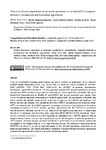Density functional dependence of molecular geometries in lanthanide(III) complexes relevant to bioanalytical and biomedical applications

Use este enlace para citar
http://hdl.handle.net/2183/21353
A non ser que se indique outra cousa, a licenza do ítem descríbese como Atribución-NoComercial-SinDerivadas 3.0 España
Coleccións
- GI-REACT! - Artigos [120]
Metadatos
Mostrar o rexistro completo do ítemTítulo
Density functional dependence of molecular geometries in lanthanide(III) complexes relevant to bioanalytical and biomedical applicationsAutor(es)
Data
2012-11-01Cita bibliográfica
Density Functional Dependence of Molecular Geometries in Lanthanide(III) Complexes Relevant to Bioanalytical and Biomedical Applications. Adrián Roca-Sabio, Martín Regueiro-Figueroa, David Esteban‐Gómez, Andrés de Blas, Teresa Rodríguez‐Blas, and Carlos Platas‐Iglesias. Computational and Theoretical Chemistry 2012 999, 93–104.
Resumo
[Abstract] A set of 15 lanthanide-containing model systems was used to evaluate the performance of 15 commonly available density functionals (SVWN, SPL, BLYP, G96LYP, mPWLYP, B3LYP, BH&HLYP, B3PW91, BB95, mPWB95, TPSS, TPSSh, M06, CAM-B3LYP and wB97XD) in geometry determination, benchmarked against MP2 calculations. The best agreement between DFT optimized geometries and those obtained from MP2 calculations is provided by meta-GGA and hybrid meta-GGA functionals. The use of hybrid-GGA functionals such as BH&HLYP and B3PW91 also provide reasonably good results, while B3LYP provides an important overestimation of the metal–ligand bonds. The performance of different basis sets to describe the ligand(s) atoms, as well as the use of large-core (LC) RECPs and small-core (SC) RECPs, has been also assessed. Our calculations show that SCRECP calculations provide somewhat shorter GdIII–donor distances than the LCRECP approach, the average contraction of bond distances for the systems investigated amounting to 0.033 Å. However, geometry optimizations with the SCRECP (in combination with the mPWB95 functional and the 6-31G(d) basis set for the ligand atoms) take about 15 times longer than the LC counterparts, and about four times longer than MP2/LCRECP/6-31G(d) calculations. The 6-31G(d), 6-311G(d), 6-311G(d,p) or cc-pVDZ basis sets, in combination with LCRECPs, appear to offer an adequate balance between accuracy and computational cost for the description of molecular geometries of LnIII complexes. Electronic energies calculated with the the cc-pVxZ family (x = D-6) indicate a relative fast convergence to the complete basis set (CBS) limit with basis set size. The inclusion of bulk solvent effects (IEFPCM) was shown to provoke an important impact on the calculated geometries, particularly on the metal–nitrogen distances. Calculations performed on lanthanide complexes relevant for practical applications confirmed the important effect of the solvent on the calculated geometries.
Palabras chave
Lanthanides
Density functional calculations
MRI contrast agents
Solvent effects
Effective core potentials
f-elements
Density functional calculations
MRI contrast agents
Solvent effects
Effective core potentials
f-elements
Versión do editor
Dereitos
Atribución-NoComercial-SinDerivadas 3.0 España
ISSN
2210-271X






